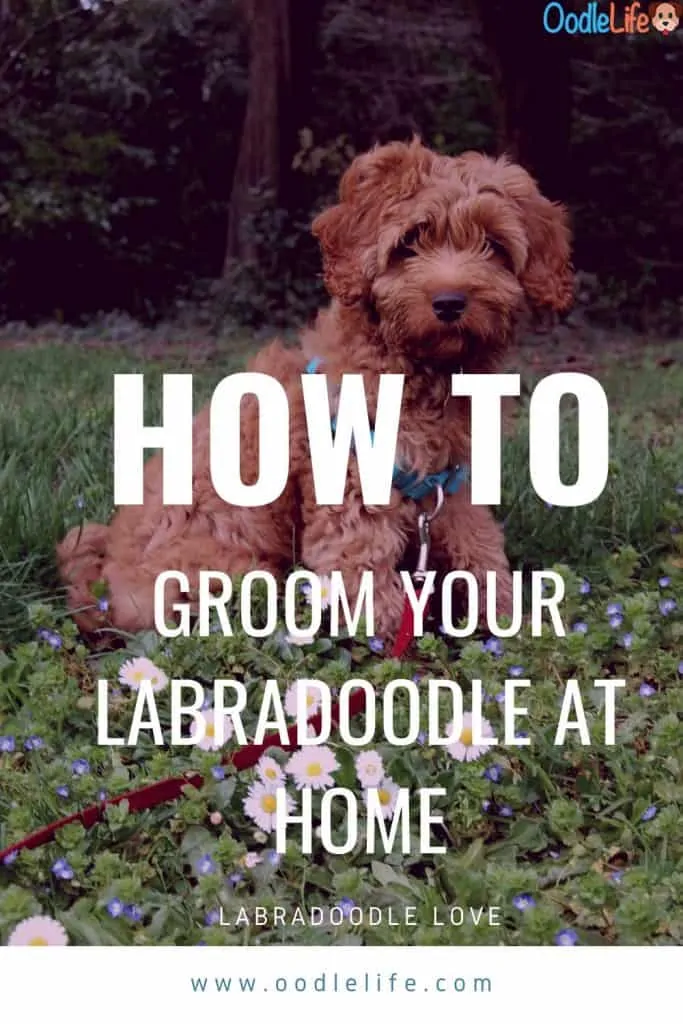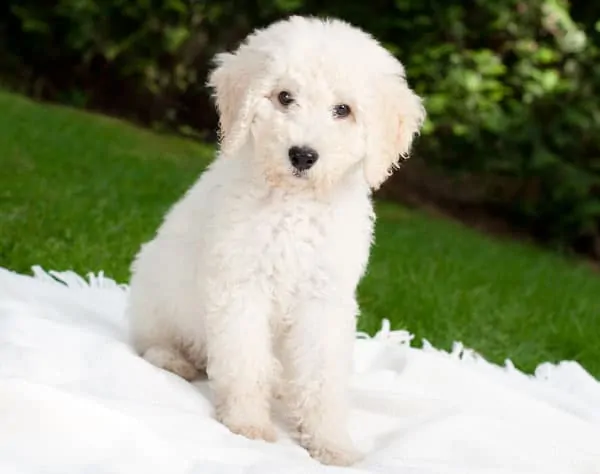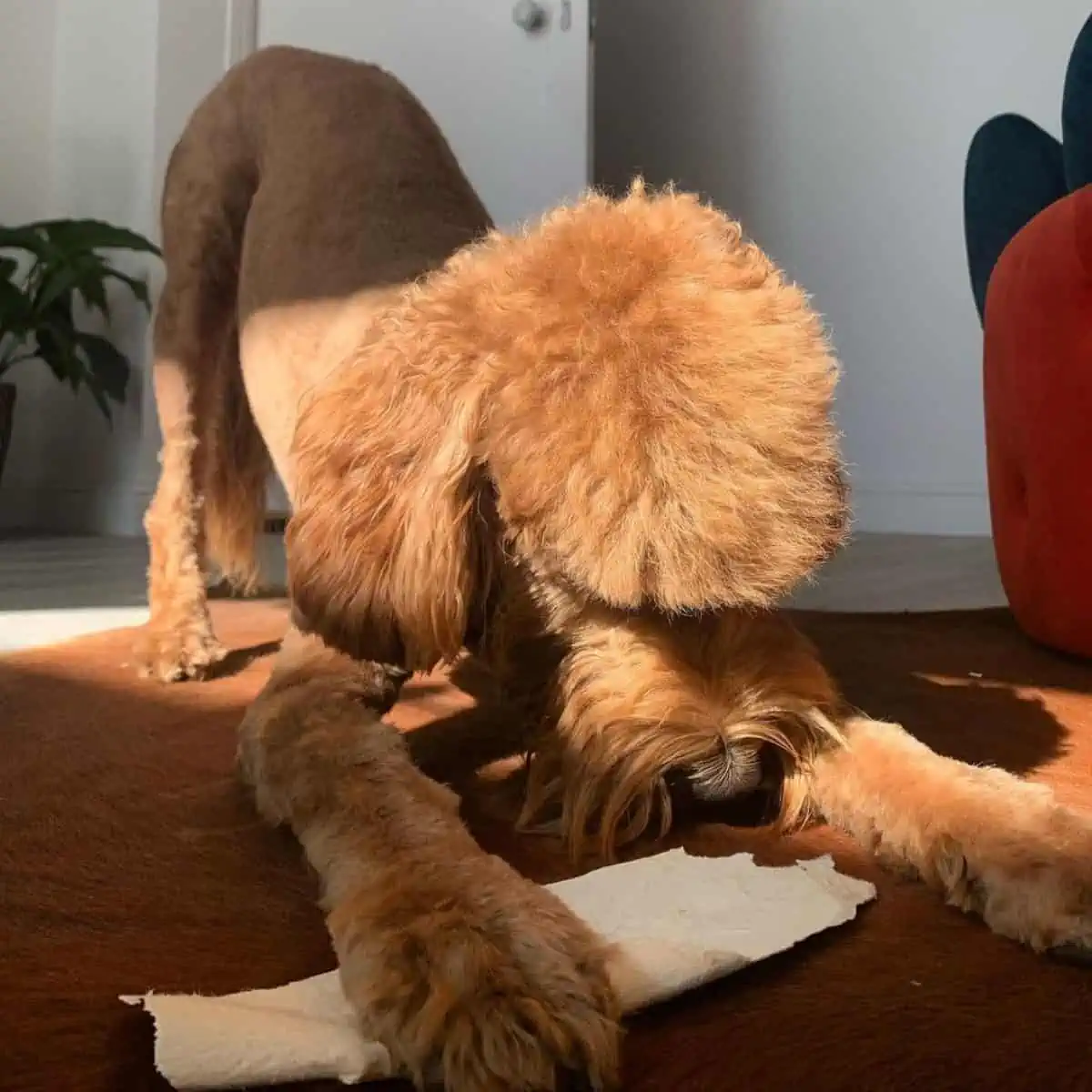Labradoodle Grooming Guide – 11 Simple Australian Labradoodle Grooming Tips For Easy DIY Grooming
Labradoodles are an amazing Poodle Mix breed. They reign supreme as the undisputed most popular Poodle Cross according to 14 years of Google Search Trend data.

A primary reason for the enduring popularity of the Labradoodle and Australian Labradoodle are their non-shedding coat. It can be such low shedding that some Labradoodles are allergy friendly.
There is no such thing as a hypoallergenic dog but many Poodle Crosses come close.
A low shedding coat does NOT mean low maintenance
In fact, maintaining the coat of a non-shedding dog like a Labradoodle requires some hands on grooming. The frequency is higher than dogs that have a short coat or straight coat.
We are fortunate that the majority of Labradoodle grooming can easily be completed at home.
Labradoodle Grooming Guide: How Often Should They Be Groomed?
This is one of the most common questions posed by Labradoodle owners. It depends on the type of coat and also the age of your dog.
- Wavy coat and Curly coat Labradoodles require frequent care
- Straight coat or improper coat Labradoodles have lower maintenance
As a general rule most Labradoodle owners say three to four weeks between light trims and a detailed groom at a Groomer (or DIY at home) every three months.
Labradoodles can have either curly and wavy coats, or straight coat. The former tends to require more grooming.
The curlier the coat, the more likely your labradoodle will need more frequent trips to the groomer, trimming by your own hand, or both.

Labradoodle Puppy Coat Change
One thing to watch for with this Poodle mix breed is their characteristic Labradoodle coat change. If you’ve owned a Labradoodle before, you’ll know that puppies have a different kind of coat than that possessed by their adult counterparts.
Even before that change takes place you should start prepping your puppy’s fur at three months of age. Introduce your dog to grooming processes like shampooing (use the best Labradoodle puppy shampoo) early.
This early introduction to brushing and grooming is especially important around areas which can be sensitive such as their paws and hind quarters (butt).
Part of the importance of brushing and grooming isn’t merely keeping your dog looking cute, but keeping these sensitive areas tangle-free and improving your dog’s comfort level.
With that labradoodle coat change comes an uptick in how often you’ll need to brush and groom your pet. You will need to groom quite a few different parts of the dog.
Our Labradoodle grooming guide below has the details you need. Adult Labradoodle coats are usually more thick and curly.
Check our 35 Indoor Dog Games and Activities to keep your Goldendoodle busy inside!

You will have to brush out curls and potential tangles a few times a week.
In addition, a trip to a professional groomer every four to six weeks is recommended. They will be able to help get some of the trickier tangles out, provide general grooming and clipping services, and bathe your dog, which we’ll cover shortly.
On the flip side from a dog owning convenience standpoint, Labradoodles tend to shed far less than other breeds. If you are looking for a dog breed that doesn’t shed much, Labradoodles remain an amazing pick! Let’s not forget how lucky we are to have the beautiful low shedding Labradoodle coat.

Bathing Your Labradoodle
Labradoodles love to swim. They get muddy and messy, which means they can collect a lot of mud in their already-matted curls.
This means Labradoodles need to be bathed in between haircut and grooming appointments.
How much they need to be bathed will naturally depend on how messy you allow them to get, though a bath every couple of weeks is reasonable. We should try not to overwash our Labradoodles as this can damage the oils in their coat.

Some tips for bathing a Labradoodle include:
- Give your dog a quick, light once over with a labradoodle brush before bath time
- Choose a shampoo that is specially formulated to help with curly dog fur
- Pay lots of attention to their ear areas, which are quite sensitive and can get tangles easily, but can also become infected if left wet, so be sure to wipe your dog’s ears completely dry
- Brush out tangles again after you’ve dried your dog off
Some dogs actually thrive in the shower rather than the bath. As long as you can protect the ears and have enough space, some owners find it much easier to bathe your dog in the shower. We do this sometimes with our miniature Labradoodle Max. Be incredibly mindful of slippery surfaces in the bath OR shower. If your dog damages a vital ligament by slipping on tiles it is a painful (and expensive) injury.
Best Brushes for Labradoodle Grooming
When grooming labradoodles, half the battle is grooming out tangles. You, need to be armed with a brush that’s up to the task. That said, some of best Labradoodle brushes are quite different from one another, and can handle different tasks.
For example, some brushes are built to provide great overall coverage. Others are more specialized, designed for purposes such as getting out tangles and mats.
Another difference comes in where the brushes are best employed. Some can be used for nearly the whole body with ease, while others are more specialized and intended for use in “problem areas” such as near the eyes or hind quarters.
One takeaway from this is that there is no one best brush for labradoodles. You can talk to your groomer about which brushes are best for the different brushing situations you are bound to face.
To make it even trickier, different Labradoodles respond differently to different brushes. Some dogs more skittish or anxious come brushing time.
Other Labradoodles have sensitive skin. For these Labradoodles, you’ll want to seek out brushes that are on the softer side and feature soft yet firm bristles and pins.

Best Clippers for Labradoodle Grooming
In addition to brushing, keeping your Labradoodle’s coat well-trimmed is essential to the grooming process. It is therefore essential to have some quality Labradoodle clippers on hand to keep their masses of thick curly fur in check.
One of the big divides you’ll face is between corded and cordless clippers. This won’t shock you but the difference between corded and cordless Labradoodle clippers is… exactly what you would expect!
Corded clippers tend to be used by professionals. They are often more powerful and longer-lasting than their cordless counterparts, though they can also be a bit more expensive as a result. What’s more, these clippers are quite durable, making them hard to break.
Cordless clippers, by contrast, are a more casual option for those who do not feel like spending for a top-tier corded clipper. Because of their cordless nature, they run on batteries, which you will either have to replace or recharge with regularity.
One advantage cordless clippers have over their corded counterparts is the fact that their cord-free nature makes them far more portable. With these, you can trim your labradoodle’s hair on the go, which can be useful if you plan on traveling with them for an extended period of time.
It also means you can opportunistically trim your Labradoodle away from a power outlet if you get the opportunity.
The more relaxed a Labradoodle is when you trim their paws, the happier they will be. Get them while they are snoozing on the couch!
Another thing to pay attention to when choosing different labradoodle clippers is the speed at which they operate. Clippers tend to come in everything from one to five-speed models, with models offering greater speed and power typically costing more.
Finally, you’ll want to consider getting add-ons such as clip-on heads that can change the shape and nature of your trimming. These add-ons can give you a greater degree of control over what your Labradoodle’s fur looks like at the end of the trimming process.

Labradoodle Brushing and Trimming Recommendations by Area
One of the most important things to keep in mind when grooming your labradoodle is that different parts of their body require different amounts and types of brushing.
Some short-haired dog breeds just require a quick once over with a brush. Labradoodles’ thick, luscious curly coat requires a lot more care than that, and some regions are especially sensitive.

Grooming Around Labradoodle Eyes
For example, you always want to make sure that your labradoodle’s vision is unobstructed, which can be a bit tricky when they constantly have curls cropping up around the eye and nose area.
You’ll, therefore, need to brush these areas as flat as possible without completely destroying the curls. Do not leave any curls dangling over the eye area, and be sure to keep this region especially clean, lest your dog develop an eye infection.
Use blunt ended scissors to clean the hair that blocks your Labradoodle’s eyes.
Grooming Labradoodle Ears
You’ll also want to make sure that your labradoodle ear hair length is kept to half an inch or an inch at maximum. Do not allow them to grow any longer than that. Tempting as doing so might be, it can make for a headache when it comes to dealing with the frustrating matted fur that’s sure to ensue.
If your Labradoodle’s ear hair looks closer to a Cocker Spaniel’s than other Labradoodles, chances are you’re letting it grow a bit too long.
One reason shorter ear hair for labradoodles is so important is that it can help prevent ear infections that might otherwise ensue.
Shorter hair around the ears can allow for more air flow, which in turn can help prevent bacteria and wax from getting trapped and building up in your dog’s ear canal.
You still must clean keep your Labradoodle’s ear canal as clean and hair-free as possible. Hair which grows here can collect into matted clumps and cause discomfort.
You will want to use labradoodle clippers for around the ear, and good old fashioned tweezer (or fingers) to pluck the Labradoodle ears. It is really easy to clean Labradoodle ears at home.
See our explanation and guide on Labradoodle ear cleaning. Otherwise you take your dog to a professional groomer to have this done.
Trimming Labradoodle Paws
Your Labradoodle’s paws, by contrast, should thankfully be a bit less high maintenance. They should simply be clipped clean and free of curls near the underside of the paws so as to prevent dogs stepping on and tracking mud into them.
Simple electric clippers or scissors should do for maintaining a short, neat trim all around your dog’s paws.
Labradoodle Muzzle Grooming (Teddy Bear Cut!)
You will also want to keep the hair length around your dog’s muzzle at an inch or less. Longer than that, and food and water can have a tendency to collect and get stuck there.
Labradoodle Tail Grooming
Tails are one of the biggest problem areas for matting, so you’ll want to be careful about how long you allow it to grow here. Two to three inches should be a good length.
Feathering the curls out can give a nice effect without allowing it to grow too long.
By contrast, hair must be kept quite short around the hind quarters – no more than half an inch – so as to prevent waste from collecting there when your dog goes to the bathroom.
Overall Labradoodle Coat Length
Finally, there’s the question of how long to allow your Labradoodle body coat to be. This will vary from owner to owner depending on personal taste and how your particular labradoodle’s coat grows.
Keep in mind that the longer you allow the coat to become, the more you’ll have to brush it.
Another consideration must be the environment you live in. Our Labradoodle Max looks like Chewbacca when his hair gets long. It is super cute!
We live in Australia however, and the extra long coat is very warm in summer or when we take Max to the beach. We chose a shorter trim during these warmer months.
Labradoodle Grooming Cost Considerations
The time and cost of Labradoodle grooming must be a consideration for all future owners. The Labradoodle coat is low to no shedding, soft, and as close to hypoallergenic as you can get in many cases.
The trade off is increased time spent grooming. Luckily there are many at-home Labradoodle grooming tips and tricks to make your life easier.
An average groom for a medium Labradoodle or Australian Labradoodle can run up to $50 USD. Given this is required every few months, the costs can add up. DIY at-home Labradoodle grooming can save a bunch of cash and give great results.
Let us know in the comments how you groom your Labradoodle at home!